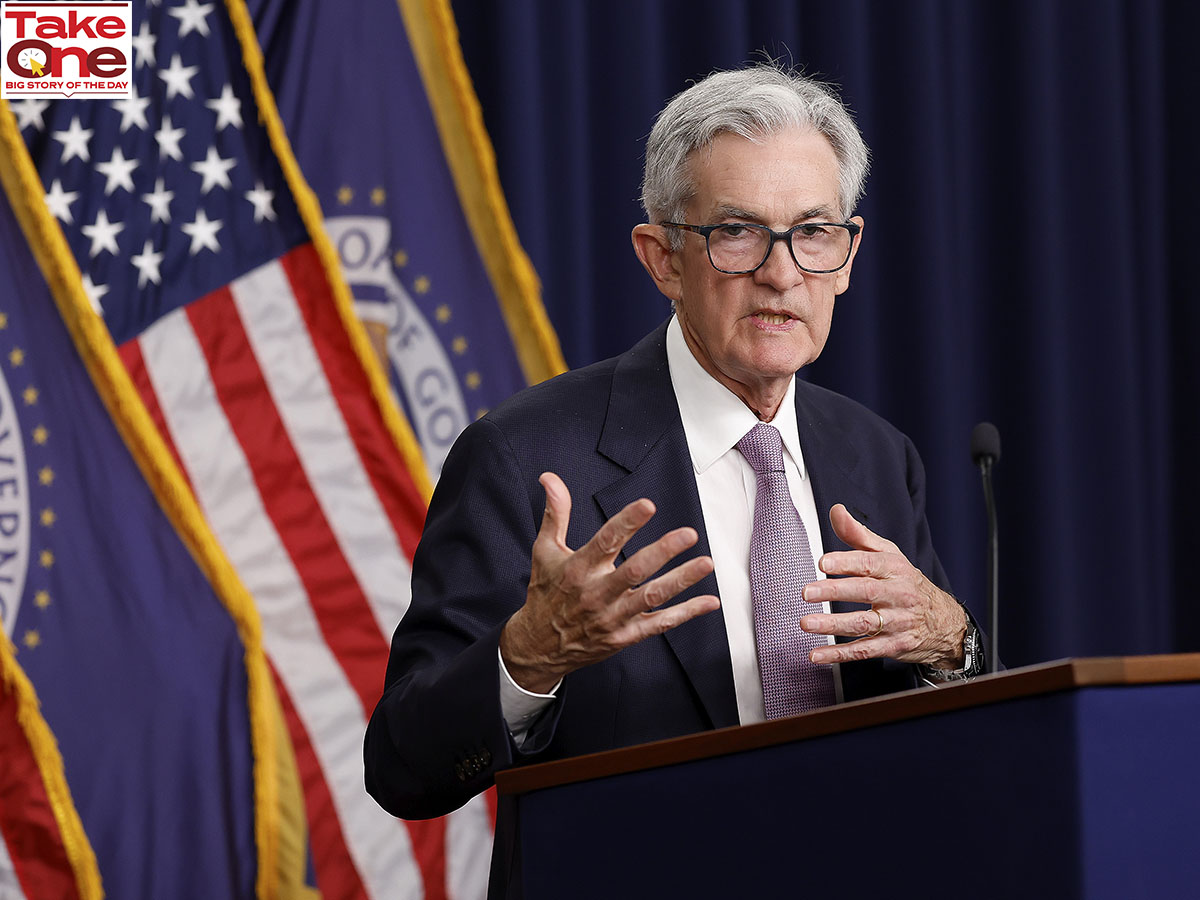 Federal Reserve Chairman Jerome Powell speaks during a news conference following the September meeting of the Federal Open Market Committee at the William McChesney Martin Jr. Federal Reserve Board Building on September 18, 2024 in Washington, DC. The Federal Reserve announced today that they will cut the central bank’s benchmark interest rate by 50 basis points to a new range of 4.75%-5%.
Federal Reserve Chairman Jerome Powell speaks during a news conference following the September meeting of the Federal Open Market Committee at the William McChesney Martin Jr. Federal Reserve Board Building on September 18, 2024 in Washington, DC. The Federal Reserve announced today that they will cut the central bank’s benchmark interest rate by 50 basis points to a new range of 4.75%-5%.
Image: Anna Moneymaker/Getty Images
After holding the policy rate for 14 straight months, the Federal Open Market Committee (FOMC) slashed the benchmark rate, which stood at a 23-year high in the range of 5.25 percent to 5.5 percent, by 50 basis points, for the first time in four years, to manoeuvre a ‘soft-landing’ and save the world’s largest economy from crashing into a feared recession.
The US central bank, since March 2022, has cumulatively raised the policy rate by 5.25 percent to control rising price levels. US inflation declined from its historic peak of 9.1 percent in June 2022 to a three-year low of 2.5 percent in August, marginally above the rate-setting panel’s target of 2 percent.
Immediately after the US Federal Reserve announced the rate cut, the S&P 500 and the Dow Jones Industrial Average hit fresh highs. But intriguingly, despite the jumbo move by the Jerome Powell-led committee, the US stock markets ended the trading session in the red as investors digested the fine print of the monetary policy outcome.
The Summary of Economic Projections (SEP), or the dot-plot, shows a clear shift in forecasts of the rate trajectory in the coming months: 19 FOMC members see the benchmark rate at 4.4 percent by CY24-end. The US central bank estimates interest rates at 3.4 percent next year. It sees another half-point cut in 2026 with rates likely to fall to 2.9 percent. The message is clear. The US Federal Reserve is in no rush to go back to the world of ultra-low interest rates or the era of cheap money.
“I do not think that anyone should look at this and say, ‘Oh, this is the new pace’,” Powell emphasised at a post-meeting press conference. “There’s nothing in the SEP that suggests that the committee is in a rush to get this done. This process evolves over time,” he reiterated, terming the rate cut as a “recalibration” of US monetary policy rather than a pivot. “We are not on any preset course. We will continue to make our decisions meeting by meeting.”
Interestingly, the size of the rate cut wasn’t a unanimous decision. Fed Governor Michelle Bowman had voted to trim rates by 25 bps instead of a super-sized reduction of 50 bps.
Half-percentage-point rate cuts are fairly uncommon and have generally been used mostly in times of crisis events such as the coronavirus pandemic in 2020. And the global financial crisis in 2008. Some investors and economists argue that the latest move by the FOMC may be unwarranted against the current economic backdrop with the US economy growing by 3 percent in the second quarter.
This suggests that the US central bank is fairly confident that the decline in inflation is sustainable and is focusing on achieving a soft-landing to avoid an economic downturn.
Also read: The global importance of the Bank of Japan and Japanese politics
“I don’t see anything in the economy right now that suggests that the likelihood of a recession, sorry, of a downturn, is elevated,” Federal Reserve Chair Jerome Powell highlighted. “You see growth at a solid rate. You see inflation coming down. You see a labour market that’s still at very solid levels. So, I don’t really see that now.”
Powell stated that the US Fed is trying to achieve a situation of price stability without any kind of painful increase in unemployment that sometimes comes with disinflation.
Investors on Dalal Street rejoiced as the benchmark indices, Sensex and Nifty 50 opened the trading session at record high levels. At 12.17 pm, the Sensex and Nifty 50 were up by 0.29 percent and 0.26 percent each.
Unmesh Kulkarni, managing director senior advisor, Julius Baer India, says the “bold” 50 bps cut is justified given the current economic data in the US. “The long-awaited Fed pivot is finally here,” he adds. “The FOMC has gained confidence that inflation is moving towards its 2 percent target on a sustained basis, and, therefore, it has chosen to focus on avoiding an undue rise in employment.”
Going forward, Kulkarni expects the FOMC to cut the policy rate by another 50 bps by the end of CY24, and another 100 bps in the next calendar year. Kotak Mahindra AMC’s managing director Nilesh Shah is hopeful that the rate cut by the US Federal Reserve will facilitate flows into emerging market assets with weaker dollar and lower rates.
Kulkarni believes Indian stocks are richly valued at current levels. “This may limit the near-term upside unless there is a runaway global rally. Moreover, if the probability of a global hard landing rises, Indian equities could witness higher volatility,” he points out.
Though inflation in India is higher than the Reserve Bank’s target of 4 percent, many economists believe the Monetary Policy Committee is likely to follow the US Fed rate action when it meets next month.
